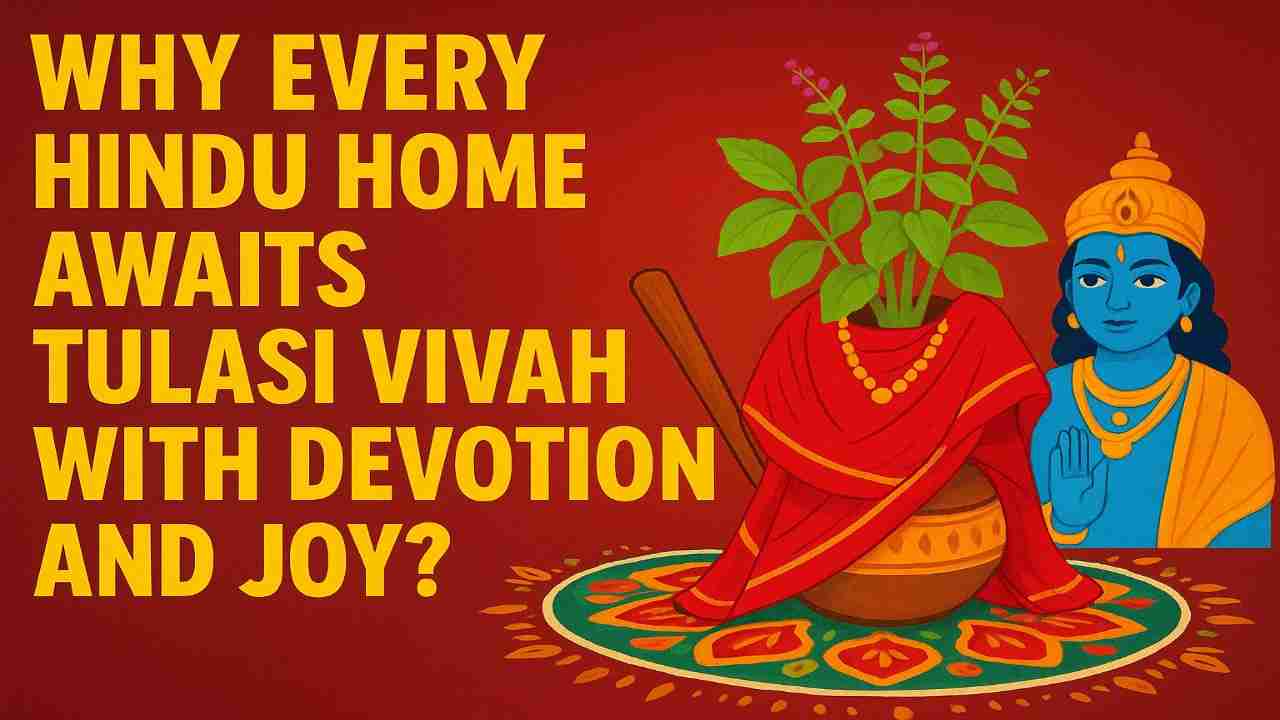
Have you ever wondered why Hindus treat the Tulsi plant as more than just a herb? In many Indian homes, Tulsi is worshipped daily, considered a living goddess, and offered to Lord Vishnu during rituals. Among the most beautiful Hindu festivals is Tulasi Vivah, the symbolic wedding of Goddess Tulsi (Holy Basil) to Lord Vishnu.
In this blog, we’ll explore what is Tulsi Vivah, the mythological stories behind it, how it is celebrated, the cultural importance of Tulasi Vivah rangoli, and the lessons it holds for devotees today.
What is Tulsi Vivah?
Tulasi Vivah is a Hindu festival that marks the ceremonial marriage of the sacred Tulsi plant to Lord Vishnu or his incarnation, Lord Krishna. It is celebrated on the Dwadashi (12th lunar day) of the Shukla Paksha (waxing moon) in the month of Kartika (October–November).
This festival is especially significant because it:
- Symbolically ends the Chaturmas period (four months when auspicious ceremonies like weddings are generally avoided).
- Marks the beginning of the Hindu wedding season.
- Brings together devotees in a joyous ritual of divine union.
Thus, Tulasi Vivah is not only a religious event but also a cultural celebration, blending devotion, family traditions, and community spirit.
Mythological Significance of Tulasi Vivah
The origin of Tulasi Vivah is rooted in ancient Hindu mythology. There are several legends that explain why this ritual is celebrated:
1. The Story of Vrinda and Jalandhar
- Vrinda, a pious devotee of Lord Vishnu, was married to the demon king Jalandhar.
- Her chastity and devotion made Jalandhar invincible. Even gods could not defeat him in battle.
- To protect the universe, Lord Vishnu disguised himself as Jalandhar and deceived Vrinda, breaking her chastity. As a result, Jalandhar was killed.
- Feeling betrayed, Vrinda cursed Vishnu to turn into a black stone (Shaligram). She then immolated herself.
- From her ashes grew the sacred Tulsi plant. To honor her devotion, Vishnu declared that Tulsi would be forever married to him. This symbolic marriage is celebrated as Tulasi Vivah.
2. Tulsi and Krishna
Another tradition associates Tulsi with Lord Krishna. In this version, Tulsi is regarded as his beloved, and the Tulasi Vivah ceremony represents their eternal spiritual bond.
Both stories highlight devotion, sacrifice, and the divine recognition of purity and love.
Rituals and Celebration of Tulasi Vivah
The celebration of Tulasi Vivah varies across regions but usually follows a common ritual pattern:
1. Preparation of the Tulsi Plant
- The Tulsi plant, usually kept in a decorated earthen pot (Tulsi Vrindavan), is dressed like a bride.
- The plant is adorned with a red sari, bangles, bindis, and flowers.
- A sugarcane stalk is placed nearby, symbolizing her groom’s home.
2. Representation of the Groom
- A Shaligram stone (symbol of Lord Vishnu) or an idol of Krishna/Narayana is decorated as the groom.
- Sometimes, temples also use idols for a grand ceremonial wedding.
3. The Wedding Ceremony
- The marriage rituals closely resemble Hindu weddings.
- Devotees chant mantras, recite prayers, and perform the kanyadaan (giving away the bride).
- Tulsi and Vishnu/Krishna are symbolically tied together with a sacred thread.
- Offerings of sweets, fruits, and prasad are distributed among devotees.
4. Feasting and Festivities
- Families prepare festive meals and invite relatives.
- Communities come together for collective prayers and celebrations.
In essence, Tulasi Vivah transforms homes and temples into wedding venues of the divine, creating an atmosphere of devotion and joy.
Cultural Significance of Tulasi Vivah
The Tulasi Vivah is not just about mythology, it has deep cultural and spiritual significance:
- Devotional Importance: Tulsi is considered the most sacred offering to Lord Vishnu. Worshipping her during the Vivah is believed to remove sins and grant blessings.
- Beginning of Marriage Season: Traditionally, no marriages or auspicious ceremonies are held during the four-month Chaturmas. Tulasi Vivah opens the doors to weddings and festivities.
- Symbol of Harmony: The union of Tulsi and Vishnu symbolizes harmony between nature and divinity.
- Family Bonding: Celebrating this festival strengthens family ties, as rituals are performed together with devotion and joy.
Tulasi Vivah Rangoli – A Colorful Tradition
One of the most eye-catching traditions of Tulasi Vivah is the creation of Tulasi Vivah rangoli.
- Devotees design rangoli patterns around the Tulsi Vrindavan to beautify the wedding venue.
- Common motifs include lotus flowers, peacocks, conch shells, and wedding symbols like mandaps.
- Bright colors like red, yellow, green, and white are used, representing prosperity and celebration.
- Many families pass down specific rangoli designs through generations, making it a cultural legacy.
Creating Tulasi Vivah rangoli is considered auspicious, as it not only beautifies the ritual space but also invites positive energy and divine blessings.
Regional Variations of Tulasi Vivah
The celebration of Tulasi Vivah differs across India:
- Maharashtra: Families decorate the Tulsi plant as a bride and perform rituals with community feasts.
- Gujarat & Rajasthan: Grand processions with music and dance are common. Tulasi Vivah rangoli is an essential part of the decorations.
- North India: Observed with great devotion in temples, where Tulsi is worshipped with Vishnu idols.
- South India: Tulasi is revered as Lakshmi, and her wedding with Vishnu is celebrated with temple rituals and music.
These regional practices highlight the rich diversity of Indian traditions while uniting everyone under the common theme of devotion to Tulsi and Vishnu.
Lessons from Tulasi Vivah
The symbolic wedding of Tulsi and Vishnu teaches timeless values:
- Devotion is eternal – Tulsi’s devotion was so strong that she became inseparable from Vishnu.
- Purity attracts divinity – Tulsi represents purity, humility, and love—qualities cherished in spiritual life.
- Sacrifice transforms into blessing – Vrinda’s sacrifice gave rise to Tulsi, the sacred plant worshipped in every Hindu household.
- Nature is divine – By worshipping Tulsi, devotees acknowledge the sacredness of plants and the environment.
Tulasi Vivah is more than a ritual. It’s a spiritual celebration of devotion, purity, and divine union. From the mythological story of Vrinda to the colorful traditions of Tulasi Vivah rangoli, the festival beautifully blends mythology, culture, and spirituality.
By celebrating Tulasi Vivah, devotees honor Goddess Tulsi, seek Lord Vishnu’s blessings, and welcome the season of auspicious marriages.
Want to explore more festivals and their meanings? Check out our other blogs on Hindu traditions and their timeless wisdom.

